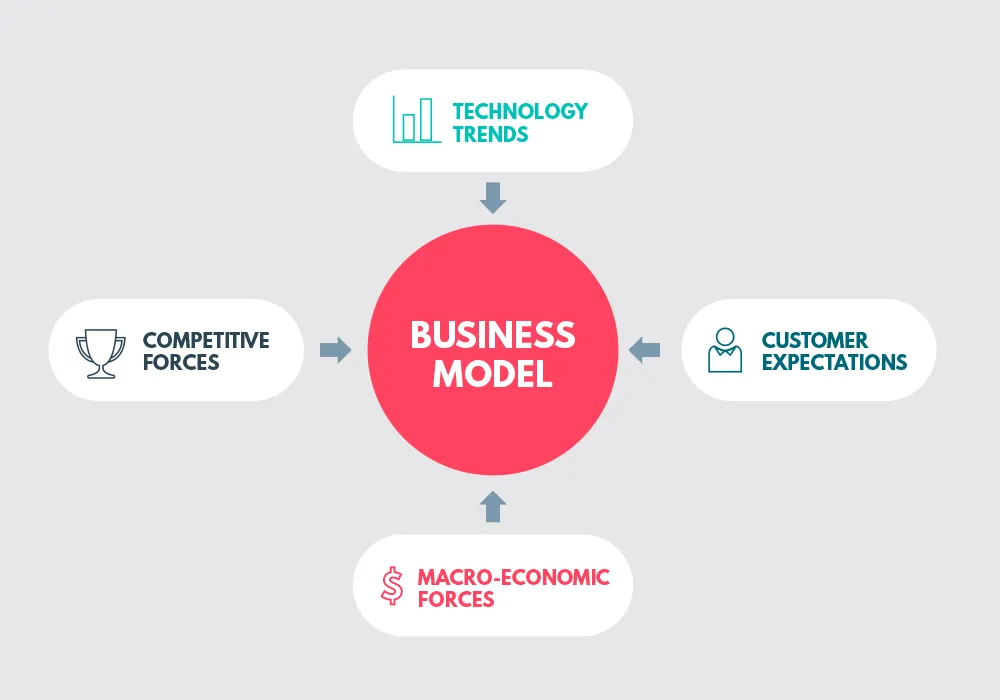-
Jun 10 2018 SUSTAINING DIGITAL TRANSFORMATION
Part 3 of 3: Business & Digital Transformation (Read Part 1 and Part 2)
Digital transformation begins with weaving a consistent thread of digital modification across your organization’s corporate fabric. Keeping that momentum going, however, is easier said than done. According to Altimeter’s 2016 State of Digital Transformation, only 29% of the companies have established a multi-year roadmap for transformation — a telling example of how sustaining digital transformation efforts beyond its initial glory days remains a puzzling challenge for many organizations.

While a digital-first mindset can give brands a competitive advantage over their non-digital counterparts, if ‘being digital’ is not part of your DNA, transformation initiatives will often stall out. So what can companies do to avoid this reality?
PRIORITIZE PEOPLE AND PROCESSES TO BUILD CULTURE

The most important resources that any organization can possess are its people. The workforce. That’s because human capital creates value — value that wraps itself around your product or service and differentiates your business in the eyes of your customers.
As this value is created, your organization develops ‘processes’ that breed efficiency and reliability. To add operational scale, businesses will optimize these processes, or they’ll decide to bring in more skilled employees, or they’ll introduce new technology platforms. This balanced combination of people, processes, and platforms is what allows brands to grow and profit. But as digital transformation initiatives gain traction, far too often organizations will focus their efforts solely on upgrading platforms. The side effect? People and processes are ignored.
Digital transformation, of course, is not just centered around technology — and to sustain its momentum, businesses must invest equal time and resources towards their people and process to establish a digital-first culture.
Just because a company launched in the past 10–15 years, when ‘digital-first’ originally reared its head, does not indicate that organization is necessarily ‘being digital’. Instead, it’s about the mindset and skills that are required to adapt quickly during the transformation journey.
A company’s leadership, especially the CEO, needs to lay out the vision and clearly communicate the purpose and goals. Creating the north star for the company and rallying the troops behind a compelling vision remains the top responsibility for Chief Executives. However, most CEOs are not completely prepared for this transformation challenge. They understand the industry shifts and immediate need to evolve their company’s business model; however, they have not been trained to handle these massive changes during their career. The majority of CEOs have enjoyed stable environments and haven’t necessarily face major macro-economic shifts nor emerging competitive entrants. Couple that with constantly evolving customer expectations and technological advances, the C-level is not able to wrap their heads around what’s necessary to innovate at the pace that’s required to compete.
CREATE A TRANSFORMATION CENTER OF EXCELLENCE

One way that a company’s leadership team can steward their digital transformation initiatives is to enact a Transformation Center of Excellence (CoE) or digital steering committees. 53% of companies have informal digital transformation steering committees; while 40% have more formalized committees. Besides creating a formal infrastructure to provide accountability on Digital Transformation initiatives, the primary tasks of the Transformation CoE should include:

INSTALL CHANGE MANAGEMENT

There are two universal truths throughout any business: people don’t like change and old habits die hard. In order to eliminate traditional mindsets and legacy processes that work against your Transformation CoE, companies must find a way to motivate their employees to embrace a digital-first approach.
In 2003, McKinsey published, “The Psychology of Change Management”, a time-tested article that outlines the four building blocks that help organizations establish change management and re-shape employee behavior. Those are:

To further propel Digital Transformation adoption, companies need to modify the ways they incentivize their employees. You can’t expect transformative outcome without offering an equally transformative input. By creating a compensation structure that aligns employee actions with your organizational ambitions, you can ensure your Transformation CoE is embraced from the start.
PROCESS AND EXECUTION

Execution is where the rubber truly meets the road. This is where you either produce results, or start losing faith. Transformation CoE plays a crucial role throughout the execution phase to keep the agenda moving forward and maintaining confidence. Questioning your existing processes and optimizing them continuously should be top of mind for every manager during this phase.
Business Process Reengineering is the practice of redesigning the way work is done to better support an organization’s goals and objectives. The ‘this is not how things are done here’ mentality needs to be axed immediately. Or, ‘our unit is not responsible for this action, and now we are stuck’ has no place in a company’s new digital culture. Brands like Adobe and Intel embraced the change around them, not only evolving their product offerings from traditional, desktop-based softwares and hardwares to SAAS-based solutions, but also creating material changes to their existing business processes when it came to product development, sales and marketing, go-to-market strategies, and customer support.
The most difficult aspect of digital transformation is sustaining its momentum. To maintain inertia, companies must embed a digital culture, empower a change agent to create a Center of Excellence and lead the cause, establish a measurement framework, and deploy business management systems to sustain these efforts over a long haul.
It’s important to keep Digital Transformation from being just a flash in the pan. Because once it’s in motion, the only direction to go is forward.
Note: Originally, this article was published in Spring of 2017 on R2i website.
-
Mar 18 2018 THE PARADIGM SHIFT OF BUSINESS TRANSFORMATION
Part 1 of 3: Business & Digital Transformation (Read Part 2 and Part 3)
There’s been disruption all around us. Over the past three decades, the rise of high speed internet, exponential growth of computational power, and ever-decreasing costs of storage have drastically changed how we live, what we interact with, and how businesses operate. The democratization of data and technology gave us all easier access to things that we had never imagined before. It helped organizations to push boundaries and disrupt the status quo. However, the creative disruption process is not always easy or straight-forward.
For roughly the last 15 years, thanks to bandwidth ubiquity, we have seen successful new business models emerge and threaten conventional business practices and value propositions. Netflix displacing Blockbuster, Borders succumbing to Amazon, Uber, and Airbnb challenging traditional transportation and travel brands, and countless other examples.
Not only are technology trends shaping business models, but the ever-evolving behaviors and expectations from consumers are also impacting organizations’ current practices.
In some cases, consumers’ unintended use of products may benefit businesses to completely redefine their value proposition. The original intent transforms itself into something that’s not imagined by the company’s leaders. Kleenex is a great example. They started out in 1924 as a disposable towel used to take off make-up. Its unintended use started in 1926 after the manufacturer received tons of customer feedback indicating that most people were using the product to blow their noses. They started advertising it as such and doubled their sales. The rest is history.
Fast forward to 2016 where organizations like Under Armour have shifted their entire business model from a sports clothing company to an innovation and experience company, simply based on how their customers were using their products and interacting as a community. Organizations that are nimble enough to respond to such changing user expectations succeed wildly and make it impossible for the competition to capitalize on that change.

Competition and macro-economic forces also push organizations to reevaluate their business models. The auto and aerospace industries are well known for reacting to such forces. Boeing saw the threat of higher gas/oil prices as well as an adverse impact to the environment with continued climate changes and reacted early on to bring the revolutionary 787 Dreamliner to the market. Not only has this product had a better and different value proposition for airline companies, but it also helped Boeing to take the lead over its competitors. Similarly, Toyota, GM, and other car manufacturers reacted to rising gas prices by introducing hybrid and eventually electric cars to compete with Tesla and to go after a cost-conscious consumer sector.
A PARADIGM SHIFT
The fall of AOL, Circuit City, Kmart, Yahoo and the rise of mobile-only business such as Uber and Venmo have forced many big and small companies to re-think their own models. In industry after industry, scenarios that once appeared improbable are becoming all too real, prompting boards and CEOs of wavering businesses to embrace transformation. Transformation is one of the most overused terms in business, perhaps just behind innovation — and it’s often misunderstood and loosely used by many business leaders. This is because organizations have failed to create a shared definition of what ‘transformation’ means to them. Many times leaders use the term nebulously for incremental changes and proudly wear the badge of being transformative.
Transformation, as I see it, is a paradigm shift for organizations. It significantly alters their pace and rhythm, while improving key business drivers. The shift often results in creating, or significantly modifying, business processes and the value it yields for its customers. However, when enterprises embark on a ‘transformation’ journey, they often fail to communicate ‘why’ to employees. This is a responsibility that starts in the C-suite and must be championed from the top down. Building a compelling vision, aligning key business leaders, and enrolling service line and business unit managers into the concept will help successfully motivate the employee base to adopt and advocate for the change.
All businesses understand that change is inevitable. Eventually, every brand must adapt to market shifts, consumer behaviors, and technology trends in order to survive. The difference between successful organizations and those that fail, however, is the foresight to recognize that change before it’s too late. Transformation is happening now, and the sooner brands treat it with a sense of urgency, the sooner they can spur their business forward.
Note: Originally, this article was published in Spring of 2017 on R2i website.










